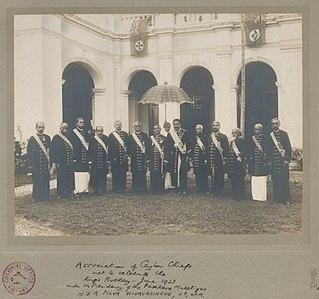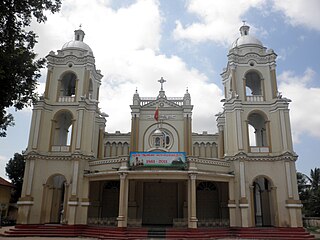Related Research Articles
The caste systems in Sri Lanka are social stratification systems found among the ethnic groups of the island since ancient times. The models are similar to those found in Continental India, but are less extensive and important for various reasons. Modern times Sri Lanka is often considered to be a casteless society in south asia.

The Nallur Kandaswamy Kovil is a Hindu temple, located in Nallur, Northern Province, Sri Lanka. The presiding deity is Murugan (Kartikeya) in the form of the divine spear vel in the sanctum, the primary shrine, and in other forms, namely, Shanmugar, Muthukumaraswami, Valli Kanthar with consorts Valli and Deivayanai, and Dandayuddhapani, sans consorts in secondary shrines in the temple.

The Jaffna kingdom, also known as Kingdom of Aryachakravarti, was a historical kingdom of what today is northern Sri Lanka. It came into existence around the town of Jaffna on the Jaffna peninsula and was traditionally thought to have been established after the invasion of Kalinga Magha from Kalinga in India. Established as a powerful force in the north, northeast and west of the island, it eventually became a tribute-paying feudatory of the Pandyan Empire in modern South India in 1258, gaining independence when the last Pandyan ruler of Madurai was defeated and expelled in 1323 by Malik Kafur, the army general of the Delhi Sultanate. For a brief period in the early to mid-14th century it was an ascendant power in the island of Sri Lanka, to which all regional kingdoms accepted subordination. However, the kingdom was overpowered by the rival Kotte kingdom around 1450 when it was invaded by Prince Sapumal under the orders of Parakramabahu VI.

The Arya Chakravarti dynasty were kings of the Jaffna Kingdom in Sri Lanka. The earliest Sri Lankan sources, between 1277 and 1283, mention a military leader of this name as a minister in the services of the Pandyan Empire; he raided the western Sri Lankan coast and took the politically significant relic of the Buddha's tooth from the Sinhalese capital city of Yapahuwa. Political and military leaders of the same family name left a number of inscriptions in the modern-day Tamil Nadu state, with dates ranging from 1272 to 1305, during the late Pandyan Empire. According to contemporary native literature, such as Cekaracecekaramalai, the family also claimed lineage from the Arya Brahmins of the prominent Hindu pilgrimage temple of Rameswaram in the modern Ramanathapuram District of India. They ruled the Jaffna kingdom from the 13th until the 17th century, when the last of the dynasty, Cankili II, was ousted by the Portuguese.
Sri Lankan Mukkuvar is a Tamil speaking ethnic group found in the Western and Eastern coastal regions of Sri Lanka. They are primarily concentrated in the districts of Puttalam, Batticaloa, and Amparai.
Karaiyar is a Sri Lankan Tamil caste found mainly on the northern and eastern coastal areas of Sri Lanka, and globally among the Tamil diaspora.

Karava is a Sinhalese speaking ethnic group of Sri Lanka, whose ancestors migrated throughout history from the Coromandel coast, claiming lineage to the Kaurava royalty of the old Kingdom of Kuru in Northern India. The Tamil equivalent is Karaiyar. Both groups are also known as the Kurukula.

Mudaliyar was a Ceylonese colonial title during Portuguese and British rule of the island. Stemming from the native headman system, the title was usually hereditary, made to wealthy influential families loyal to the British Crown.
The following is a chronological overview of the history of the Karavas and Karaiyars caste of Sri Lanka and India. Both communities were historically also known as Kurukulam, meaning Kuru clan.
Sri Lankan Vellalar is a caste in Sri Lanka, predominantly found in the Jaffna peninsula and adjacent Vanni region, who comprise about half of the Sri Lankan Tamil population. They were traditionally involved in agriculture, but also included merchants, landowners and temple patrons. They also form part of the Sri Lankan Tamil diaspora.
Kanakasooriya Cinkaiariyan was the first of the Aryacakravarti dynasty kings of Jaffna Kingdom to lose complete power to a rival king. He inherited the throne from his father Gunaveera Cinkaiariyan in 1440. He was deposed in 1450 by Sapumal Kumaraya a military leader sent by Parakramabâhu VI from the rival Kotte Kingdom in the south. Number of primary sources such as Rajavaliya and Kokila Sandesa written in Sinhalese vividly describe the planning and conquest of the Jaffna Kingdom.

The Vanni chieftaincies or Vanni tribes was a region between Anuradhapura and Jaffna, but also extending to along the eastern coast to Panama and Yala, during the Transitional and Kandyan periods of Sri Lanka. The heavily forested land was a collection of chieftaincies of principalities that were a collective buffer zone between the Jaffna Kingdom, in the north of Sri Lanka, and the Sinhalese kingdoms in the south. Traditionally the forest regions were ruled by Vedda rulers. Later on, the emergence of these chieftaincies was a direct result of the breakdown of central authority and the collapse of the Kingdom of Polonnaruwa in the 13th century, as well as the establishment of the Jaffna Kingdom in the Jaffna Peninsula. Control of this area was taken over by dispossessed Sinhalese nobles and chiefs of the South Indian military of Māgha of Kalinga (1215–1236), whose 1215 invasion of Polonnaruwa led to the kingdom's downfall. Sinhalese chieftaincies would lay on the northern border of the Sinhalese kingdom while the Tamil chieftaincies would border the Jaffna Kingdom and the remoter areas of the eastern coast, north western coast outside of the control of either kingdom.
Bhuvanekabahu VI of Kotte, also known as Sapumal Kumaraya and Chempaka Perumal, was an adopted son of Parakramabahu VI, whose principal achievement was the conquest of Jaffna Kingdom in 1447 or 1450. Bhuvanaikabahu was apparently summoned south after the demise of his adopted father. He then ruled for 17 years. According to Rajavaliya, he killed the grandson of Parakrama Bahu VI, namely Vira Parakrama Bahu or Jaya Bahu.
Social class in Sri Lanka is often described as casteless, though caste is still found on the island in both a symbolic and a practical sense. Caste is also used in an analogous sense to refer to the new social class divisions that have appeared in recent decades. The combination of ethnic nationalist movements that saw caste as an island-wide dividing tool, strong emphasis on providing access to education and healthcare regardless of background, and historic lack of discrimination among the colonial civil service played a factor in eradicating the caste system in most sectors of the island's society. Although the Buddhist culture actively fought against all forms of class discrimination, many Buddhist organizations used caste as a method to extract surplus from temple property.

Lascarins is a term used in Sri Lanka to identify indigenous soldiers who fought for the Portuguese during the Portuguese era (1505–1658) and continued to serve as colonial soldiers until the 1930s. The lascarins played a crucial role not only in the colonial armies, but also in the success of the campaigns of the local kingdoms.

The Kingdom of Kotte, named after its capital, Kotte, was a Sinhalese kingdom that flourished in Sri Lanka during the 15th century.
Vira Parakramabahu VIII, also known as Ambulagala Kumara, was King of Kotte in the fifteenth century, who ruled from 1484 to 1518. He succeeded Parakramabahu VII and was succeeded by his son Dharma Parakramabahu IX. Another son Vijayabahu VII also became king.

Gurunagar is a coastal village in Jaffna city in northern Sri Lanka. Gurunagar is also known as Karaiyur.
Madapalli is a caste found mainly in the northern part of Sri Lanka. Found today as a subcaste of the Sri Lankan Vellalar, the Madapallis were considered an independent caste until recently.
Mukkuvar is a maritime ethnic group found in the Indian states of Kerala, Tamil Nadu and the Eastern and North Western coastal regions of Sri Lanka. They are mostly found on the Malabar Coast, South Travancore Coast and Kanyakumari district, Tamil Nadu, who have traditionally been involved in fishing and other maritime activities.
References
- ↑ N. Fernando, A. Denis (1987). Peninsular Jaffna from Ancient to Medieval Times: Its Significant Historical and Settlement Aspects. Journal of the Royal Asiatic Society of Sri Lanka, Vol. 32. p. 83. JSTOR 23731055.
- ↑ Nadaraja, Tambyah (1972-01-01). The Legal System of Ceylon in Its Historical Setting. Brill Archive. pp. 34–35. ISBN 9004036377.
- ↑ McGilvray, Dennis B. (2008). Crucible of Conflict: Tamil and Muslim Society on the East Coast of Sri Lanka. Duke University Press. p. 61. ISBN 0822341611.
- ↑ Kurukshetra, Volume 4. University of Michigan: Sri Lak-Indo Study Group. 1978. p. 86.
- ↑ The Ceylon Antiquary and Literary Register. 1922. p. 2.
- ↑ Journal of the Royal Asiatic Society of Sri Lanka. Royal Asiatic Society of Sri Lanka. 1998. p. 166.
- 1 2 M.D., Raghavan (1961). The Karava of Ceylon. University of Pennsylvania: K. V. G. De Silva. pp. 14–16.
- ↑ "Sapumal Kumaraya and Puran Appu - Later avatars of Prince Aba?". www.srilankaguardian.org. Retrieved 2017-03-05.
- ↑ Kurukshetra, Volume 2. University of Michigan: Sri Lak-Indo Study Grou. 1976. p. 25.
- ↑ Fernando, A. Denis N. "Dona Catherina was the direct heiress by virtue of her heredity". Info Lanka.